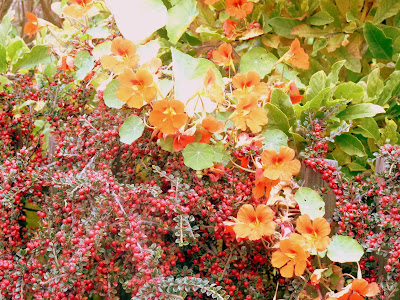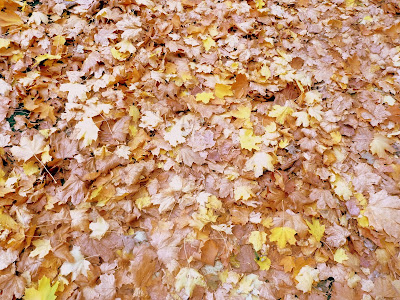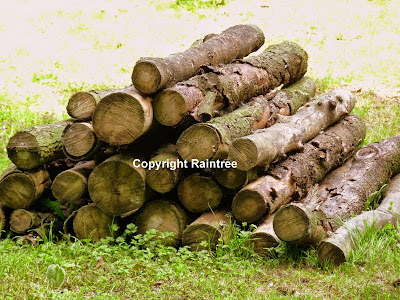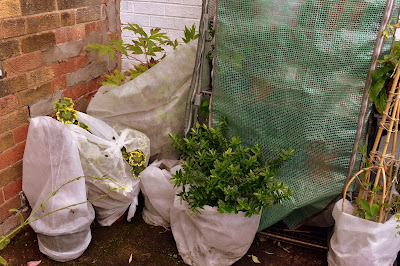During late October and early November, I start putting the garden to bed. I like that expression, it makes me feel like I am doing my last caring duties for our garden this year and then the garden and myself can rest in the long cold dark days of winter.
Of course, there will always be jobs to do all year round. I do need to prune the climbing roses and I need to do a little hedge cutting later on, but the bulk of the autumn work in our garden is over and the best thing I can do now is to enjoy the autumn colors of the trees and plants still flowering or bearing berries and then let it rest.
What Is Putting The Garden To Bed?
Well for us it is to make sure that the plants in the garden can survive a winter full of winds, gales, heavy rain and snow.
Protect Plants From Wind Damage
I need to make sure that plants are not too damaged by high winds. So for example we have several lovely Buddleia and Lavataria.
All summer they have given us beautiful flowers and attracted many bees and butterflies. They all grow very tall so are at risk of wind rock and breaking branches. So about October, I reduce their height using loppers by about half. This prevents any issues and still gives a decent size plant at about 4 feet high. In Spring I will prune the Buddleia to about a foot high but this autumn prune is simply to prevent damage.
I repeat this with any other shrubs or plants that may be in danger. For this, depending on the thickness of growth you may use loppers or shears or these Wolf ByPass Secateurs
However, never prune Spring flowering plants now or you will not have any flowers next year. Also, it is too late to prune lavender now as any tender new growth may be frost-damaged.
Care Of The Grass In Winter
The last cut here will be around the end of October. We tend to leave the grass a little longer over winter but it is a personal thing. We use a manual lawnmower which suits our small lawn and us very well. If you are considering a new lawnmower here is my review of the Benefits And Drawbacks Of A Manual Lawnmower.
It is useful to do autumn spiking of the lawn with a fork or special tool then brush grit into the holes to help with drainage. If you feel the lawn needs feeding now is the time to give it an autumn feed.
The other main thing to do is to keep off the grass if you can when it is sodden with rain. Walking on it too much will cause damage.
Uses Of Autumn Leaves
Gather fallen leaves into a wire netting bin or wooden bin or in bags with holes punched in for drainage, water well and leave to rot down so you can have lovely free leaf mold this time next year!
Add a layer of mulch to your borders. A thick layer of leaves or compost will enrich the soil and make it a great habitat for worms and other beneficial insects that love to live in the soil.
Here Are More Details On The Joys And Uses Of Autumn Leaves
Make A Wildlife Habitat This Autumn
One of the best things we can do this Autumn/Fall is to make more habitat for wildlife in our gardens. Anything we need to cut down do not throw away but make into a big pile in a quiet corner of the garden. I aim for as little as possible to leave the garden, rather to recycle it within the garden.
This pile of logs, leaves, sticks will make a great winter retreat for insects, spiders, hedgehogs and all manner of overwintering creatures.
In turn, they will make your garden a healthier more balanced place for predators and prey and nature to work is magic.
Fleecing Tender Plants In Autumn
One of the main tasks we do is to buy a great roll of fleece and proceed to wrap up all the tender of more delicate plants. We do not have a large greenhouse so they all have to stay outdoors and most would not survive a winter left to fend for themselves.
If you do have a greenhouse then it is easy to just move all your tender plants in for the winter.
However, I have found that a thick protective covering of fleece works really well. All I need to do then is to brush any snow off it.
So each plant and most of these tender plants are in pots receives a cosy wrapping of fleece all the way around the pot base and the foliage. I leave the top open for if its a nice day but with enough material so I can close it right over if the weather is brutal.
For many of the plants, I am most worried about the roots. If the foliage dies down or gets wind burnt it will usually grow back if the roots are strong.
However, if the roots become frost-bound or starved of oxygen the plant will die. So especially for plants in pots, it is vital to protect the roots if nothing else.
Ideally and especially for terracotta pots, you would first wrap the pot in bubble wrap or hessian then wrap the fleece over it and the foliage. If you do not have bubble wrap then use fleece over all of it.
For plants that really do not like our winters such as our beautiful Bottle Brush Plant I fleece them and also bring them into our sheltered porch.
Do buy the thicker fleece if you can. I have tried different fleeces and the thinner ones tear too easily and I usually have to double wrap the plant to feel it is protected.
With the thicker fleece, although slightly more expensive you only need to single wrap and so far I have not had any trouble with tearing.
Move Tender Plants to A Sheltered Spot
After all the tender pants are fleeced up I move them to their winter homes.
This is a place where they are kept as safe from high winds and cold as possible so against a house wall is good. Our Tree Peony in particular hates strong winds. I group them together so that they get shelter from each other.
As I do this before Halloween it has to be said that when all wrapped up our plants do look somewhat like cute little ghosts especially after dark and particularly when my husband decides to elaborate by putting black netting, lights or eyes and ghostly additions !!! The neighbourhood children do love it though!
Care of Herbaceous Perennials
For herbaceous perennials, the best thing you can do in autumn is nothing at all!
It used to be the time to tidy up all the herbaceous perennials, cutting them down and generally tidying them up.
However, we now know that many insects use these plants to overwinter in their stems and foliage. For them, our untidy garden is a warm safe home. In order for nature to survive and thrive there is a worry that Are We Too Tidy In Our Gardens?
So for the good of nature and to relieve us of a task, we now need to do nothing. When new growth starts in the spring and the insects are no longer needing their warm homes and shelter and protection we can then cut back the old growth.
Protection of Tender And New Cuttings Over Winter
Any tender and new cuttings I took are in small pots and I move all these into our little greenhouse on the patio for winter. It has a cover I can take off if the weather is reasonable and put down when it is cold or particularly windy.
It is not heated and does not need to be, it just keeps the worst of the weather off the new cuttings and keeps them mostly free from frost. If I did not have this I would use a cold frame or even cover them all with fleece.
General Care Of The Garden In Winter
So when we have completed all these tasks it is so lovely to know that all our precious plants are warm and cosy and ready to rest through the winter.
I will of course need to periodically check them over to see that they are doing well. On sunny days I will uncover some of the less tender ones so they get some sunshine and remain hardy.
If it snows heavily I will brush off the worst from the plants. Other than that I do not need to concern myself with them.
Then all we gardeners need to do is to sit down with a lovely mug of whatever you like, put your feet up, enjoy the beautiful autumn sights in the garden. Perhaps take a moment to drink in the beauty of your own autumn garden, window box, or patio and in nature and start dreaming of and planning for spring!
Take The Time to Stop Look and Listen In Your Garden
More Gardening Reviews From Contributors On Review This Reviews





































Very helpful gardening advice, Jasmine, for preparing your garden for it's deep winter's sleep. :) Your advice covers just about every aspect of 'winterizing' a garden to ensure a healthy & happy garden come next Spring.
ReplyDeleteJasmine This is a great review. I particularly like how you talk about leaving a place for insects etc to retreat for the cold weather.
ReplyDeleteI love the recommendation of using fleece to protect those venerable plants that must stay outdoors during the winter. I've never considered using fleece. What a great idea! It is clear you really love your garden, Jasmine. You are an awesome caregiver with some truly wonderful ideas.
ReplyDeleteWow, what a thorough and helpful guide to “putting a garden to bed” for the winter! I love that expression and the image it conjures up of all the green and growing things snuggling down for a long winter’s nap. The idea of using fleece to protect plants we can’t bring indoors is ingenious and new to me. Thanks so much for sharing your gardening wisdom with us, Jasmine. No wonder your plants love you!
ReplyDeleteMy husband is in charge of all the yard work. So much is required to get the yard ready for winter!
ReplyDelete